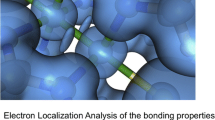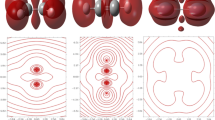Abstract
A new concept of bond order density of shared electron pairs is introduced to study the electronic structure in molecules. This BODSEP analysis is applied to the distortion of benzene toward its building blocks (acetylenes), metalloporphyrins and two recent examples from the literature. The S12g/TZ2P results show the gradual disappearance of the bonds while distorting benzene and strengthening the bonds in acetylene to reach a final triple bond value. A large range of bond orders are observed for the metalloporphyrins, which are consistent with aromaticity indices from the literature [Can. J. Chem. 2009, 87, 1063]; with an ideal value of 1.5 for aromatic molecules (because of resonance), it suggests that (BODSEP) bond orders might be used for aromaticity measures. Finally, the delocalized bonds in porphyrins are localizing in the corrphycenes, and bond order strengths for different spin states of dipyrrolonaphthyridinedione have been assigned, which differ from the original description.





Similar content being viewed by others
References
Shaik S (2016) Chemistry as a game of molecular construction: the bond-click way. Wiley, Hoboken
Steiner S, Wolf J, Glatzel S, Andreou A, Granda JM, Keenan G, Hinkley T, Aragon-Camarasa G, Kitson PJ, Angelone D, Cronin L (2019) Organic synthesis in a modular robotic system driven by a chemical programming language. Science 363(6423):2211. https://doi.org/10.1126/science.aav2211
García-Simón C, Costas M, Ribas X (2016) Metallosupramolecular receptors for fullerene binding and release. Chem Soc Rev 45:40–62. https://doi.org/10.1039/C5CS00315F
García-Simón C, Garcia-Borràs M, Gómez L, Parella T, Osuna S, Juanhuix J, Imaz I, Maspoch D, Costas M, Ribas X (2014) Sponge-like molecular cage for purification of fullerenes. Nat Commun 5:5557. https://doi.org/10.1038/ncomms6557
Lozano D, Álvarez-Yebra R, López-Coll R, Lledó A (2019) A flexible self-folding receptor for coronene. Chem Sci 10:10351–10355. https://doi.org/10.1039/C9SC03158H
Romero-Rivera A, Garcia-Borràs M, Osuna S (2017) Computational tools for the evaluation of laboratory-engineered biocatalysts. Chem Commun 53:284–297. https://doi.org/10.1039/C6CC06055B
Maria-Solano MA, Iglesias-Fernández J, Osuna S (2019) Deciphering the allosterically driven conformational ensemble in tryptophan synthase evolution. J Am Chem Soc 141:13049–13056. https://doi.org/10.1021/jacs.9b03646
Serrano-Plana J, Oloo WN, Acosta-Rueda L, Meier KK, Verdejo B, Garcia-Espana E, Basallote MG, Munck E, Que L Jr, Company A, Costas M (2015) Trapping a highly reactive nonheme iron intermediate that oxygenates Strong C–H bonds with stereoretention. J Am Chem Soc 137(50):15833–15842. https://doi.org/10.1021/jacs.5b09904
Dantignana V, Serrano-Plana J, Draksharapu A, Magallón C, Banerjee S, Fan R, Gamba I, Guo Y, Que L, Costas M, Company A (2019) Spectroscopic and reactivity comparisons between nonheme oxoiron(IV) and oxoiron(V) species bearing the same ancillary ligand. J Am Chem Soc 141:15078–15091. https://doi.org/10.1021/jacs.9b05758
Toropov AA, Carbó-Dorca R, Toropova AP (2018) Index of Ideality of Correlation: new possibilities to validate QSAR: a case study. Struct Chem 29:33–38. https://doi.org/10.1007/s11224-017-0997-9
Barroso JM, Besalú E (2005) Design of experiments applied to QSAR: ranking a set of compounds and establishing a statistical significance test. J Mol Struct (THEOCHEM) 727:89–96. https://doi.org/10.1016/j.theochem.2005.02.051
Besalú E, Gironés X, Amat L, Carbó-Dorca R (2002) Molecular quantum similarity and the fundamentals of QSAR. Acc Chem Res 35:289–295. https://doi.org/10.1021/ar010048x
Carbó-Dorca R (2018) Toward a universal quantum QSPR operator. Int J Quantum Chem 118:e25602. https://doi.org/10.1002/qua.25602
Carbó-Dorca R, Damme SV (2007) Solutions to the Quantum QSPR problem in molecular spaces. Theor Chem Acc 118:673–679. https://doi.org/10.1007/s00214-007-0352-0
Carbó-Dorca R, Gironés X (2005) Foundation of quantum similarity measures and their relationship to QSPR: density function structure, approximations, and application examples. Int J Quantum Chem 101:8–20. https://doi.org/10.1002/qua.20191
Garcia-Borràs M, Osuna S, Swart M, Luis JM, Solà M (2013) Electrochemical control of the regioselectivity in the exohedral functionalization of C60. The role aromaticity. Chem Commun 49:1220–1222. https://doi.org/10.1039/C2CC38390J
Ortiz de Montellano PR, De Voss JJ (2002) Oxidizing species in the mechanism of cytochrome P450. Nat Prod Rep 19:477–493. https://doi.org/10.1039/B101297P
Osuna S, Swart M, Solà M (2011) The reactivity of endohedral fullerenes. What can be learnt from computational studies? Phys Chem Chem Phys 13(9):3585–3603. https://doi.org/10.1039/c0cp01594f
Feixas F, Solà M, Swart M (2009) Chemical bonding and aromaticity in metalloporphyrins(1,2). Can J Chem Revue Canadienne De Chimie 87(7):1063–1073. https://doi.org/10.1139/v09-037
Swart M (2007) Metal-ligand bonding in metallocenes: differentiation between spin state, electrostatic and covalent bonding. Inorg Chim Acta 360(1):179–189. https://doi.org/10.1016/j.ica.2006.07.073
Rosa A, Ricciardi G, Baerends EJ (2006) Synergism of porphyrin-core saddling and twisting of meso-Aryl substituents. J Phys Chem A 110:5180–5190. https://doi.org/10.1021/jp060931i
Liptak MD, Wen X, Bren KL (2010) NMR and DFT investigation of heme ruffling: functional implications for cytochrome c. J Am Chem Soc 132:9753–9763. https://doi.org/10.1021/ja102098p
Bren KL (2012) NMR spectroscopy of paramagnetic heme proteins. Curr Inorg Chem 2:273–291. https://doi.org/10.2174/1877944111202030273
Bowman SE, Bren KL (2008) The chemistry and biochemistry of heme c: functional bases for covalent attachment. Nat Prod Rep 25(6):1118–1130. https://doi.org/10.1039/b717196j
Li Manni G, Alavi A (2018) Understanding the mechanism stabilizing intermediate spin states in Fe(II)-Porphyrin. J Phys Chem A 122:4935–4947. https://doi.org/10.1021/acs.jpca.7b12710
Mayer I (1983) Charge, bond order and valence in the ab initio SCF theory. Chem Phys Lett 97:270–274. https://doi.org/10.1016/0009-2614(83)80005-0
Gopinathan MS, Jug K (1983) Valency. I. A quantum chemical definition and properties. Theor Chim Acta 63:497–509. https://doi.org/10.1007/BF00552652
Nalewajski RF, Mrozek J (1994) Modified valence indices from the two-particle density matrix. Int J Quantum Chem 51(4):187–200. https://doi.org/10.1002/qua.560510403
Michalak A, DeKock RL, Ziegler T (2008) Bond multiplicity in transition-metal complexes: applications of two-electron valence indices. J Phys Chem A 112:7256–7263. https://doi.org/10.1021/jp800139g
Wiberg KB (1968) Application of the pople-santry-segal CNDO method to the cyclopropylcarbinyl and cyclobutyl cation and to bicyclobutane. Tetrahedron 24(3):1083–1096. https://doi.org/10.1016/0040-4020(68)88057-3
Weinhold F, Landis CR, Glendening ED (2016) What is NBO analysis and how is it useful? Int Rev Phys Chem 35(3):399–440. https://doi.org/10.1080/0144235X.2016.1192262
Bridgeman AJ, Cavigliasso G, Ireland LR, Rothery J (2001) The Mayer bond order as a tool in inorganic chemistry. J Chem Soc Dalton Trans 14:2095–2108. https://doi.org/10.1039/B102094N
Mayer I (2007) Bond order and valence indices: a personal account. J Comput Chem 28(1):204–221. https://doi.org/10.1002/jcc.20494
Bickelhaupt FM, Baerends EJ (2000) Kohn-Sham density functional theory: Predicting and understanding chemistry. In: Lipkowitz KB, Boyd DB (eds) Reviews in Computational Chemistry, vol 15. Reviews in Computational Chemistry. Wiley-VCH, New York, pp 1–86. https://doi.org/10.1002/9780470125922.ch1
Yagi A, Shinokubo H (2020) Meso-diazacorrphycenes: neighboring effect of two nitrogen atoms. Chem A Eur J 26(37):8210–8213. https://doi.org/10.1002/chem.202002053
Wang L, Lin L, Yang J, Wu Y, Wang H, Zhu J, Yao J, Fu H (2020) Singlet fission in a pyrrole-fused cross-conjugated skeleton with adaptive aromaticity. J Am Chem Soc 142(23):10235–10239. https://doi.org/10.1021/jacs.0c00089
Baerends EJ, Ziegler T, Atkins AJ, Autschbach J, Bashford D, Bérces A, Bickelhaupt FM, Bo C, Boerrigter PM, Cavallo L, Chong DP, Chulhai DV, Deng L, Dickson RM, Dieterich JM, Ellis DE, Faassen Mv, Fan L, Fischer TH, Fonseca Guerra C, Franchini M, Ghysels A, Giammona A, van Gisbergen SJA, Götz AW, Groeneveld JA, Gritsenko OV, Grüning M, Gusarov S, Harris FE, Heine T, van den Hoek P, Jacob CR, Jacobsen H, Jensen L, Kaminski JW, van Kessel G, Kootstra F, Kovalenko A, Krykunov MV, van Lenthe E, McCormack DA, Michalak A, Mitoraj M, Morton SM, Neugebauer J, Nicu VP, Noodleman L, Osinga VP, Patchkovskii S, Pavanello M, Peeples CA, Philipsen PHT, Post D, Pye CC, Ravenek W, Rodríguez JI, Ros P, Rüger R, Schipper PRT, van Schoot H, Schreckenbach G, Seldenthuis JS, Seth M, Snijders JG, Solà M, Swart M, Swerhone D, te Velde G, Vernooijs P, Versluis L, Visscher L, Visser O, Wang F, Wesolowski TA, van Wezenbeek EM, Wiesenekker G, Wolff SK, Woo TK, Yakovlev AL (2016) ADF2016. ADF2016.01, ADF2016.01 edn. SCM, Theoretical Chemistry, Vrije Universiteit, Amsterdam
Te Velde G, Bickelhaupt FM, Baerends EJ, Fonseca Guerra C, van Gisbergen SJA, Snijders JG, Ziegler T (2001) Chemistry with ADF. J Comput Chem 22(9):931–967. https://doi.org/10.1002/jcc.1056
Swart M, Bickelhaupt FM (2008) QUILD: QUantum-regions interconnected by local descriptions. J Comput Chem 29(5):724–734. https://doi.org/10.1002/jcc.20834
van Lenthe E, Baerends EJ (2003) optimized slater-type basis sets for the elements 1–118. J Comput Chem 24:1142–1156. https://doi.org/10.1002/jcc.10255
Chong DP, van Lenthe E, van Gisbergen SJA, Baerends EJ (2004) Even-tempered Slater-type orbitals revisited: from hydrogen to krypton. J Comput Chem 25:1030–1036. https://doi.org/10.1002/jcc.20030
Swart M, Snijders JG (2003) Accuracy of geometries: influence of basis set, exchange-correlation potential, inclusion of core electrons, and relativistic corrections. Theor Chem Acc 110(1):34–41. https://doi.org/10.1007/s00214-003-0443-5
Swart M (2013) A new family of hybrid density functionals. Chem Phys Lett 580:166–171. https://doi.org/10.1016/j.cplett.2013.06.045
Swart M, Gruden M (2016) Spinning around in transition-metal chemistry. Acc Chem Res 49:2690–2697. https://doi.org/10.1021/acs.accounts.6b00271
Klamt A, Schüürmann G (1993) COSMO: a new approach to dielectric screening in solvents with explicit expressions for the screening energy and its gradient. J Chem Soc Perkin Trans 2:799–805. https://doi.org/10.1039/P29930000799
Swart M, Rösler E, Bickelhaupt FM (2007) Proton Affinities in Water of Maingroup-Element Hydrides. Effects of Hydration and Methyl Substitution. Eur. J Inorg Chem 2007(23):3646–3654. https://doi.org/10.1002/ejic.200700228
van Lenthe E, Baerends EJ, Snijders JG (1993) Relativistic regular two-component Hamiltonians. J Chem Phys 99:4597–4610. https://doi.org/10.1063/1.466059
Banerjee S, Draksharapu A, Crossland PM, Fan R, Guo Y, Swart M, Que L Jr (2020) Sc3+-Promoted O–O Bond Cleavage of a (μ-1,2-Peroxo)diiron(III) Species Formed from an Iron(II) Precursor and O2 to Generate a Complex with an FeIV2(μ-O)2 Core. J Am Chem Soc 142:4285–4297. https://doi.org/10.1021/jacs.9b12081
Liao M-S, Scheiner S (2002) Electronic structure and bonding in metal porphyrins, metal=Fe Co, Ni, Cu, Zn. J Chem Phys 117:205–219. https://doi.org/10.1063/1.1480872
Kruszewski J, Krygowski TM (1972) Definition of aromaticity basing on the harmonic oscillator model. Tetrahedron Lett 13(36):3839–3842. https://doi.org/10.1016/S0040-4039(01)94175-9
Matito E, Poater J, Solà M, Duran M, Salvador P (2005) Comparison of the AIM delocalization index and the mayer and fuzzy atom bond orders. J Phys Chem A 109(43):9904–9910. https://doi.org/10.1021/jp0538464
Matito E, Salvador P, Duran M, Solà M (2006) Aromaticity measures from fuzzy-atom bond orders (FBO). The aromatic fluctuation (FLU) and the para-delocalization (PDI) indexes. J Phys Chem A 110(15):5108–5113. https://doi.org/10.1021/jp057387i
Feixas F, Matito E, Poater J, Solà M (2015) Quantifying aromaticity with electron delocalisation measures. Chem Soc Rev 44(18):6434–6451. https://doi.org/10.1039/C5CS00066A
Bird CW (1985) A new aromaticity index and its application to five-membered ring heterocycles. Tetrahedron 41(7):1409–1414. https://doi.org/10.1016/S0040-4020(01)96543-3
Jug K (1983) A bond order approach to ring current and aromaticity. J Org Chem 48(8):1344–1348. https://doi.org/10.1021/jo00156a038
Aysin RR, Leites LA, Bukalov SS (2020) Aromaticity of 1-heterocyclopropenes containing an atom of group 14 or 4. Organometallics 39(14):2749–2762. https://doi.org/10.1021/acs.organomet.0c00351
Ayub R, Bakouri OE, Jorner K, Solà M, Ottosson H (2017) Can baird’s and clar’s rules combined explain triplet state energies of polycyclic conjugated hydrocarbons with fused 4nπ- and (4n + 2)π-rings? J Org Chem 82(12):6327–6340. https://doi.org/10.1021/acs.joc.7b00906
@OttossonGroup (2020) T1 Baird-aromatic, how come? A recent JACS study (https://pubs.acs.org/doi/abs/10.1021/jacs.0c00089) claims Baird-aromaticity in T1, yet MCI(pi,beta)/MCI(pi,alpha) = 1.20 and resonance structure reveal Hückel-aromatic pyrrole rings. Spin distribution ≠ T1 Baird-aromatic and charges ≠ pyrrolinium rings. https://twitter.com/ottossongroup/status/1266744588041162752. Accessed August 25, 2020, 22.22h 2020
Jorner K, Feixas F, Ayub R, Lindh R, Solà M, Ottosson H (2016) Analysis of a compound class with triplet states stabilized by potentially baird aromatic [10] annulenyl dicationic rings. Chem A Eur J 22(8):2793–2800. https://doi.org/10.1002/chem.201504924
Swart M, van Duijnen PT, Snijders JG (2001) A charge analysis derived from an atomic multipole expansion. J Comput Chem 22(1):79–88. https://doi.org/10.1002/1096-987x(20010115)22:1<79:aid-jcc8>3.0.co;2-b
@kjelljorner (2020) This paired-unpaired EDDB analysis is very interesting Dariusz, do you have a reference for that? I would believe that the following resonance structures are a good description of the system. https://twitter.com/kjelljorner/status/1266860701483708417. Accessed August 25, 2020, 22.27h 2020
Acknowledgements
MINECO (CTQ2014-59212-P, CTQ2015-70851-ERC, CTQ2017-87392-P), FEDER (UNGI10-4E-801) and the COST Association (CM1305, ECOSTBio) are gratefully thanked for financial support, CSUC for extensive computer time and SCM for a developer's license.
Funding
MINECO, COST, CSUC, SCM.
Author information
Authors and Affiliations
Corresponding author
Additional information
Dedicated to Ramon Carbó-Dorca on the occasion of his 80th birthday.
Publisher's Note
Springer Nature remains neutral with regard to jurisdictional claims in published maps and institutional affiliations.
Published as part of the special collection of articles derived from the Chemical Concepts from Theory and Computation.
Electronic supplementary material
Below is the link to the electronic supplementary material.
Rights and permissions
About this article
Cite this article
Swart, M. Bond orders in metalloporphyrins. Theor Chem Acc 139, 160 (2020). https://doi.org/10.1007/s00214-020-02667-z
Received:
Accepted:
Published:
DOI: https://doi.org/10.1007/s00214-020-02667-z




